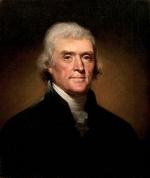|
This section contains 9,263 words (approx. 31 pages at 300 words per page) |

|
SOURCE: “Commonplaces II: Thomas Jefferson,” in On the Sources of Patriarchal Rage: The Commonplace Books of William Byrd and Thomas Jefferson and the Gendering of Power in the Eighteenth Century, New York University Press, 1992, pp. 47-73.
In the following essay, Lockridge examines Jefferson's Commonplace Book, written in his youth, noting that the selection of quotations and the writings that accompany them exhibit both rebellion and misogyny.
William Byrd was not alone in the intensely misogynistic vision rendered in his commonplace. That view of women evidently persisted in private male discourse for some time, as at least one further case testifies. Thomas Jefferson's literary commonplace book from the 1750's, 60's, and 70's has just been properly edited and its entries dated.1 One episode in it is startlingly similar.
Jefferson's is, like Byrd's, a genteel commonplace book. Its entries are designed to embody those rhetorics and understandings of the social...
|
This section contains 9,263 words (approx. 31 pages at 300 words per page) |

|


